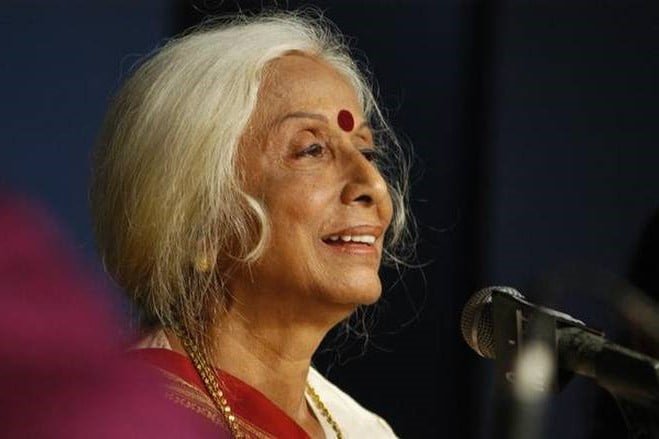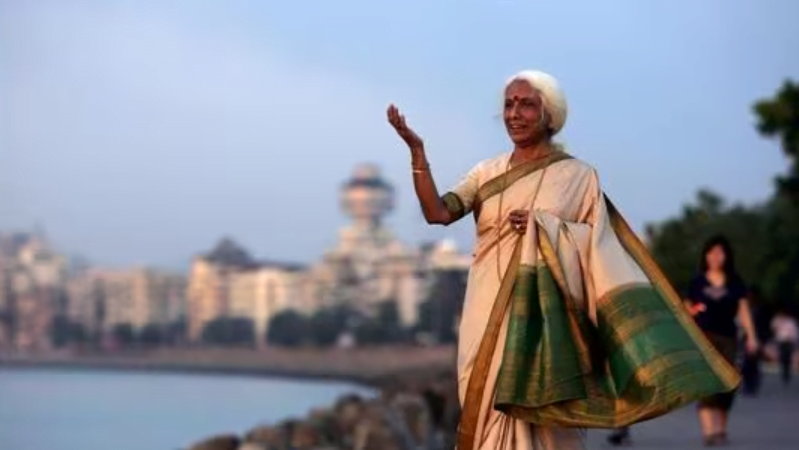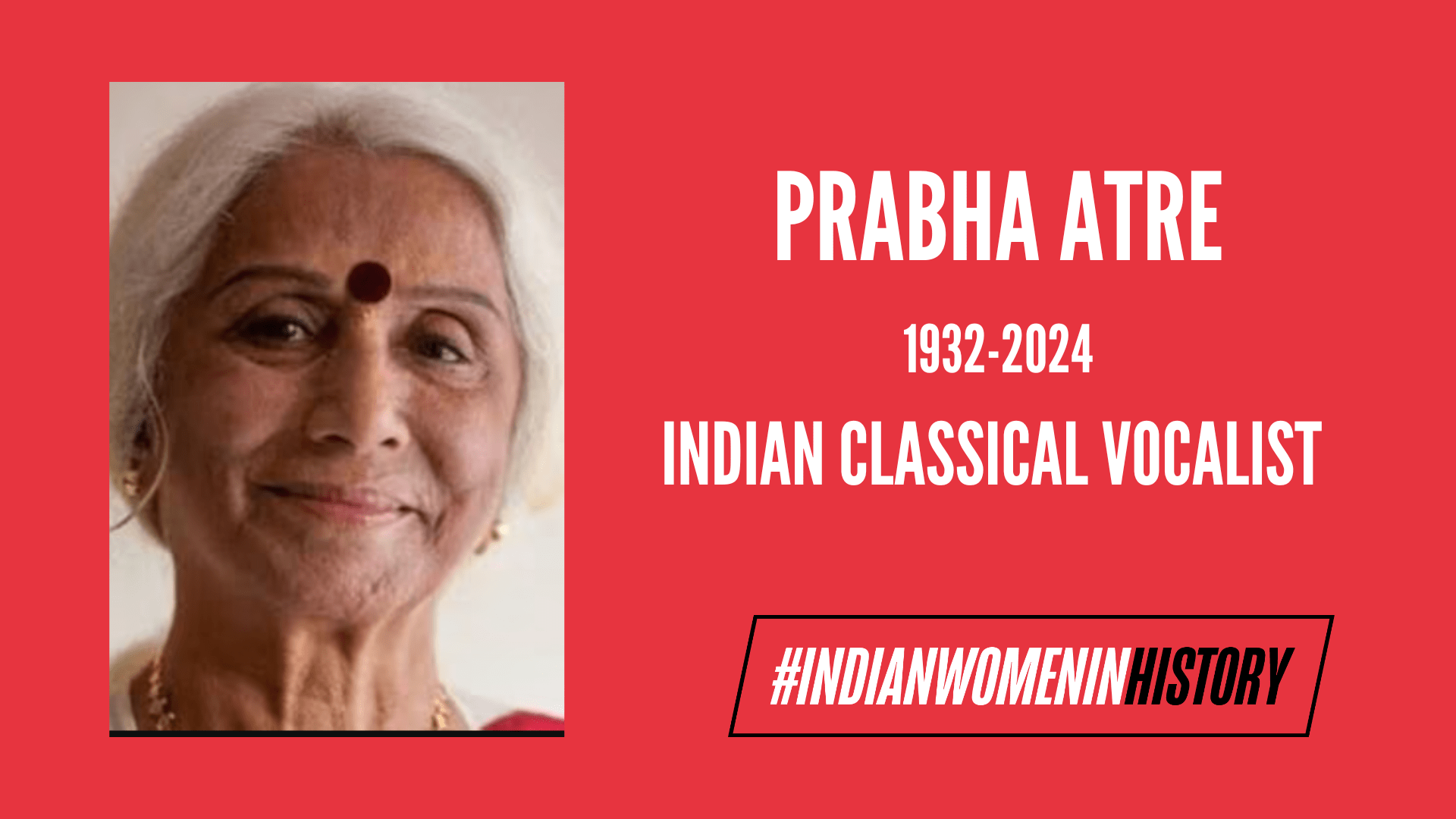Maru Bihaag is a raaga that sounds seemingly straightforward but takes great finesse to execute. It borrows its essence from two distinct parent raagas in Hindustani classical music – Bihaag and Yaman. Yaman, as a raag exudes peace, harmony, and devotion, whereas Bihaag is known to be romantic, playful, and lively even. When they come together in the serene and dignified Maru Bihaag, they make compositions that retain both these spirits.
Maru Bihaag was one of the raagas that Dr Prabha Atre sang in her first LP record, and no other raaga is a better representation of the illustrious career she has had as the last great vocalist of the Kirana Gharana. Dr Atre passed away from a cardiac arrest on January 13, 2024, at the age of 91. She leaves behind a rich legacy of virtuosity and reinvention.
Her roots
Born in 1932 in Pune, Prabha picked up a passion for music at age eight when her mother was recommended lessons in Hindustani classical to facilitate her recovery from infirmity. Prabha did not come from a lineage of artistic ascendancy that maestros of her stature often do. Indeed, she did not hail from a background where her music could have been her primary discipline of education. She was a Science and Law graduate from Fergusson College, Pune, and the University of Pune Law College respectively.

As a protege of Hirabai Badodekar, Prabha was an inheritor of a neoteric musical tradition, one that was gradually becoming more comfortable with putting its women in the limelight and giving them the acknowledgement that they deserve. Hirabai Badodekar was the first female artist in India to ever have people buy tickets to see her perform onstage. It was her pathbreaking career that reshaped the domain of classical music for others who came after her, Prabha Atre being one of them. It is clear that Hirabai bequeathed upon her disciple a propensity for questioning tradition, for harbingering change and evolution.
Dr Atre donned many hats when it came to her craft. She was an expert vocalist, a proficient composer, a skilful writer, and, most importantly, an accomplished scholar. She understood the conventions that were passed down to her better than most people, which also in turn enabled her to challenge them better than most people. She wrote her doctoral dissertation on how sargam is used in Indian classical music, an academic pursuit that aligns with the distinctive focus on the nuances of the individual swaras (notes) characteristic of the Kirana Gharana.
Sureshbabu Mane, who taught her before Hirabai Badodekar (his sister), was also a luminary of the Kirana Gharana and was responsible, along with Badodekar, for Atre’s extensive focus on Thumris and Khyaals.
Prabha Atre’s art
Prabha Atre was truly revolutionary in the manner in which she approached her art. She did not adhere to the time-honoured norms of classical music practitioners, nor was she guilty of a blind reverence to the same. Her insistence on originality and reform, evident in her scrutiny of long-standing rules and practices like time-based raaga recitals, the necessitated omission of sargams in khyaals, and the preoccupation with the theoretical form of a raaga, paved the way for a model of instruction in classical music that was not bound by an unquestioning veneration for its stipulated paradigms.

Atre’s penchant for less constrained forms of composition like khyaals reveals her commitment to creativity, imagination, and novelty within the set principles of Hindustani classical music. A Scroll article quotes her as saying:
“In our classical arts, we are still sticking to the grammar prescribed by old texts like Sangeet Ratnakar and Natya Shastra. This worked at the time when the shastras were written but we have to forge new paths for our age, change our thinking.“
Atre cited, as an inspiration for her musical inclinations, maestros like Bade Ghulam Ali Khan and Ustad Amir Khan. Her first LP, mentioned earlier in this article, was released in 1971 and was called Night Melodies, and it went on to become a massive hit, lauded by listeners for the “utter sweetness of her voice.”
Nearly every musical critic resorted to vivid imagery to describe the sound of her album; one compared it to honey, whereas another claimed it reminds them of “dark but clear water,” but of course, everyone agreed about the matchless quality of her vocals.
A Bada Khyaal in Raag Maru Bihaag in which she laments the slow passage of time preceding her anticipated reunion with her beloved, a composition in the captivating raaga of Kalavati in which she sings about offering her body, soul, and wealth to a Godlike muse, and a beautiful thumri in Khamaaj, form her first record. According to the Scroll, “For an entire generation of listeners, Maru Bihag and Kalavati came to be synonymous with Atre.“
For all her dedication to subversion, Atre did not believe in the overwhelming acrobatics of flashy taans. Her technique was as deliberative and patient as her sensibilities were progressive, and she did not let either come in the way of the other.
Prabha Atre’s defiance
Of course, it is hard to explain the impact that Atre has had on the landscape of Indian classical music by simply stating her technical expertise. She did not limit herself to solely classical music either, and was a prolific Marathi-language theatre actor and had also received Kathak training. She was the jack of nearly all performing arts and the master of one, and her contributions to classical music won her several accolades, including the Padma Shri in 1990, the Padma Bhushan in 2002, and the Padma Vibhushan in 2022, and these, most definitely, do not even begin to fulfil the debt that practitioners after her owe her.

Dr Prabha Atre was a visionary in the truest sense of the word. In an age when it would have been considered of utmost importance for a woman to “settle down,” she came in from nowhere and managed to become a living legend and in the process thwarted all the expectations imposed upon her by both the overseers of societal convention and the connoisseurs of the performing arts.
Dr. Atre wrote two theoretical treatises in both Marathi and Hindi and published two compilations of her music throughout her career. Among her books in English are the aforementioned Along the Path of Music, and Enlightening the Listener, which attempts to bridge the gap between theory and praxis in North Indian classical music.
“As a ‘sadhak,’ I am not satisfied because the learning never ends. I want to sing till the last breath,” an article in The Week quotes her as saying.
Prabha Atre was unable to perform in Pune’s Kirana Gharana festival one last time in December 2023 before her demise. She dedicated her life to the enhancement of the reach of Hindustani Classical Music and will be remembered as a stalwart of the art form for many decades to come, not only because she kept it alive, but also because she ensured that it kept rejuvenating and revitalising itself. Her Gurukul in Pune, Swaramayee, keeps her legacy intact by passing down her wisdom and her spirit of inquiry to the next generation of upcoming artists, and, as long as there is any form of heterodoxy in the discipline of classical music that causes it to constantly question its norms, her essence prevails.
About the author(s)
Adrita Bhattacharya is a Computer Science graduate from Vellore Institute of Technology and is currently pursuing a degree in English and Cultural Studies at Christ University. She has a keen interest in Linguistics, Gender Studies, and Digital Humanities.





